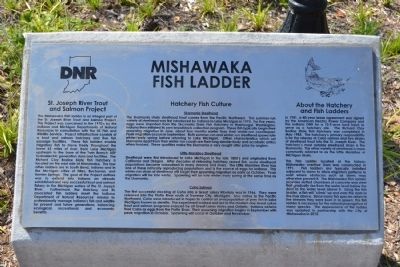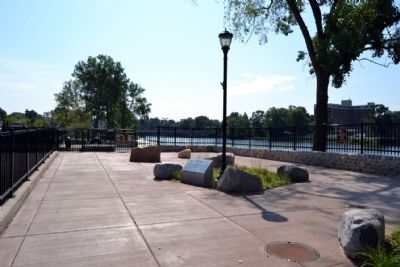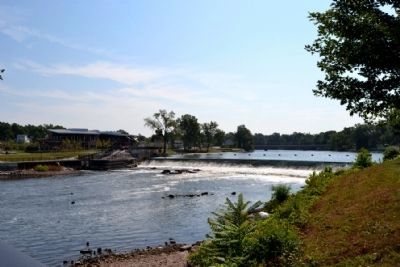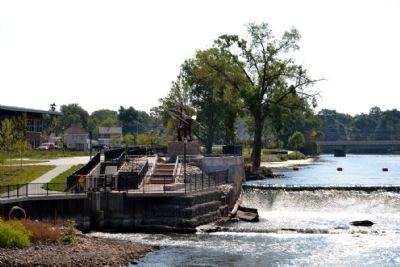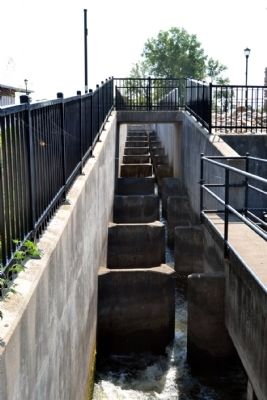Mishawaka in St. Joseph County, Indiana — The American Midwest (Great Lakes)
Mishawaka Fish Ladder
St. Joseph River Trout and Salmon Project
The Mishawaka Fish ladder is an integral part of the St. Joseph River Trout and Salmon Project. This Project was conceived in the 1970's by the Indiana and Michigan Departments of Natural Resources in consultation with the US Fish and Wildlife Service. Project infrastructure consists of a trout and salmon hatchery and five fish passage facilities. These fish ladders enable migratory fish to move freely throughout the lower 63 miles of river, from Lake Michigan upstream to the base of the Twin Branch AEP hydroelectric generation dam and facilities. The Richard Clay Bodine State Fish Hatchery is located on the east side of Mishawaka. The four other ladders are in South Bend, Indiana and in the Michigan cities of Niles, Buchanan, and Berrien Springs. The goal of the Project authors was to extend into Indiana an already established and very successful trout and salmon fishery in the Michigan waters of the St. Joseph River. Furthermore, the Hatchery and its associated fish ladders meet the Indiana Department of Natural Resources’ mission to professionally manage Indiana’s fish and wildlife for present and future generations, balancing ecological, recreational, and economic benefits.
Hatchery Fish Culture
Skamania Steelhead
The Skamania strain steelhead trout comes from the Pacific Northwest. This summer-run variety of steelhead was first introduced by Indiana to Lake Michigan in 1975. For five years, eggs were imported from the Skamania State Fish Hatchery in Washougal, Washington. Indiana then initiated its own broodstock collection program. These fish typically begin their spawning migration in June, about four months earlier than their winter-run counterpart. Peak migration occurs in September. Both summer-run and winter-run steelhead spawn late winter/early spring before returning to Lake Michigan. Other characteristics which set Skamania apart from their winter-run cousin are their long slender body and acrobatic antics when hooked. These qualities make the Skamania a very sought after prize by anglers.
Little Manistee Steelhead
Steelhead were first introduced to Lake Michigan in the late 1800's and originated from California and Oregon. After decades of releasing hatchery reared fish, some steelhead populations became naturalized in many streams and rivers. The Little Manistee River has one of these naturally reproducing populations and is the source of eggs for Indiana. This winter-run strain of steelhead will begin their spawning migration as early as October. Peak migration will be late winter. Spawning will be late winter/early spring at the same time as the Skamania.
Coho Salmon
The first successful stocking of Coho into a Great Lakes tributary was in 1966. They were released into the Platte River south of Traverse City, Michigan. Also native to the Pacific Northwest, Coho were introduced in hopes to control an overpopulation of prey fish in Lake Michigan known as alewife. The experiment worked and led to the modern day Great Lakes trout and salmon programs enjoyed by all Great Lakes states and Ontario. Indiana obtains their Coho as eggs from the Platte River. Their spawning migration begins in September with peak migration in October. Spawning will occur in October and November.
About the Hatchery and Fish Ladders
In 1981, a 40-year lease agreement was signed by the American Electric Power Company and the Indiana DNR for a 10.9-acre land track to serve as a hatchery site. The Richard Clay Bodine State Fish Hatchery was completed in 1983. The hatchery’s primary responsibility is for the release of Coho salmon and two strains of steelhead trout into the St. Joseph River. The hatchery’s most notable steelhead strain is the Skamania. The other variety of steelhead is more commonly referred to as the Little Manistee or Michigan strain.
This Fish Ladder located at the historic Mishawaka overflow Dam was constructed in 1991. Fish ladders are typically installed adjacent to dams to allow migratory patterns
to exist where obstacles such as dams may otherwise prevent it. The Mishawaka Fish Ladder provides slotted chambers of concrete and steel that gradually rise from the water level below the dam to the water level above it. Using the fish ladder, a fish will “climb” up and over the dam to the river above. Since many fish species return to the streams they were born in to spawn, this fish ladder is necessary for the natural propagation of many species. The appearance of the ladder was updated in partnership with the City of Mishawaka in 2013.
Erected 2013 by Indiana Department of Natural Resources.
Topics. This historical marker is listed in these topic lists: Animals • Environment • Waterways & Vessels. A significant historical year for this entry is 1975.
Location. 41° 39.814′ N, 86° 10.605′ W. Marker is in Mishawaka, Indiana, in St. Joseph County. Marker can be reached from the intersection of E. Mishawaka Avenue and Christyann Street. Marker is located at the north end of Mishawaka Dam next to Central Park; the above directions are to the park entrance. Touch for map. Marker is at or near this postal address: 295 E Mishawaka Ave, Mishawaka IN 46545, United States of America. Touch for directions.
Other nearby markers. At least 8 other markers are within walking distance of this marker. First Dam Across The St. Joseph River / Power Race (about 500 feet away, measured in a direct line); Ball-Band Factory
(approx. 0.3 miles away); Perkins Windmill (approx. 0.3 miles away); The Mishawaka Academic and Normal Institute (approx. 0.4 miles away); Dodge Manufacturing Company (approx. 0.4 miles away); Mishawaka Civil War Soldiers Monument (approx. half a mile away); Battell Park (approx. 0.6 miles away); Kamm & Schellinger Brewery (approx. 0.6 miles away). Touch for a list and map of all markers in Mishawaka.
Credits. This page was last revised on August 30, 2020. It was originally submitted on August 18, 2014, by Duane Hall of Abilene, Texas. This page has been viewed 1,758 times since then and 157 times this year. Photos: 1, 2, 3, 4, 5. submitted on August 18, 2014, by Duane Hall of Abilene, Texas.
